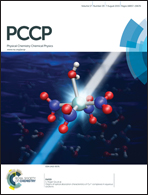Distortions of ethyne when complexed with a cuprous or argentous halide: the rotational spectrum of C2H2⋯CuF†
Abstract
A new molecule C2H2⋯CuF has been synthesized in the gas phase by means of the reaction of laser-ablated metallic copper with a pulse of gas consisting of a dilute mixture of ethyne and sulfur hexafluoride in argon. The ground-state rotational spectrum was detected by two types of Fourier-transform microwave spectroscopy, namely that conducted in a microwave Fabry–Perot cavity and the chirped-pulse broadband technique. The spectroscopic constants of the six isotopologues 12C2H2⋯63Cu19F, 12C2H2⋯65Cu19F, 13C2H2⋯63Cu19F, 13C2H2⋯65Cu19F, 12C2D2⋯63Cu19F and 12C2D2⋯65Cu19F were determined and interpreted to show that the molecule has a planar, T-shaped geometry belonging to the molecular point group C2v, with CuF forming the stem of the T. Quantitative interpretation reveals that the ethyne molecule is distorted when subsumed into the complex in such manner that the C![[triple bond, length as m-dash]](https://www.rsc.org/images/entities/char_e002.gif) C bond lengthens (by δr) and the two H atoms cease to be collinear with the C
C bond lengthens (by δr) and the two H atoms cease to be collinear with the C![[triple bond, length as m-dash]](https://www.rsc.org/images/entities/char_e002.gif) C internuclear line. The H atoms move symmetrically away from the approaching Cu atom of CuF, to increase each *
C internuclear line. The H atoms move symmetrically away from the approaching Cu atom of CuF, to increase each *![[triple bond, length as m-dash]](https://www.rsc.org/images/entities/char_e002.gif) C–H angle by δA = 14.65(2)°, from 180° to 194.65(2)°. Ab initio calculations at the explicitly-correlated level of theory CCSD(T)(F12*)/aug-cc-pVTZ lead to good agreement with the experimental geometry. It is shown that similar distortions δr and δA, similarly determined, for four complexes C2H2⋯MX (M = Cu or Ag; X = F, Cl or CCH) are approximately linearly related to the energies De for the dissociation process C2H2⋯MX = C2H2 + MX.
C–H angle by δA = 14.65(2)°, from 180° to 194.65(2)°. Ab initio calculations at the explicitly-correlated level of theory CCSD(T)(F12*)/aug-cc-pVTZ lead to good agreement with the experimental geometry. It is shown that similar distortions δr and δA, similarly determined, for four complexes C2H2⋯MX (M = Cu or Ag; X = F, Cl or CCH) are approximately linearly related to the energies De for the dissociation process C2H2⋯MX = C2H2 + MX.


 Please wait while we load your content...
Please wait while we load your content...